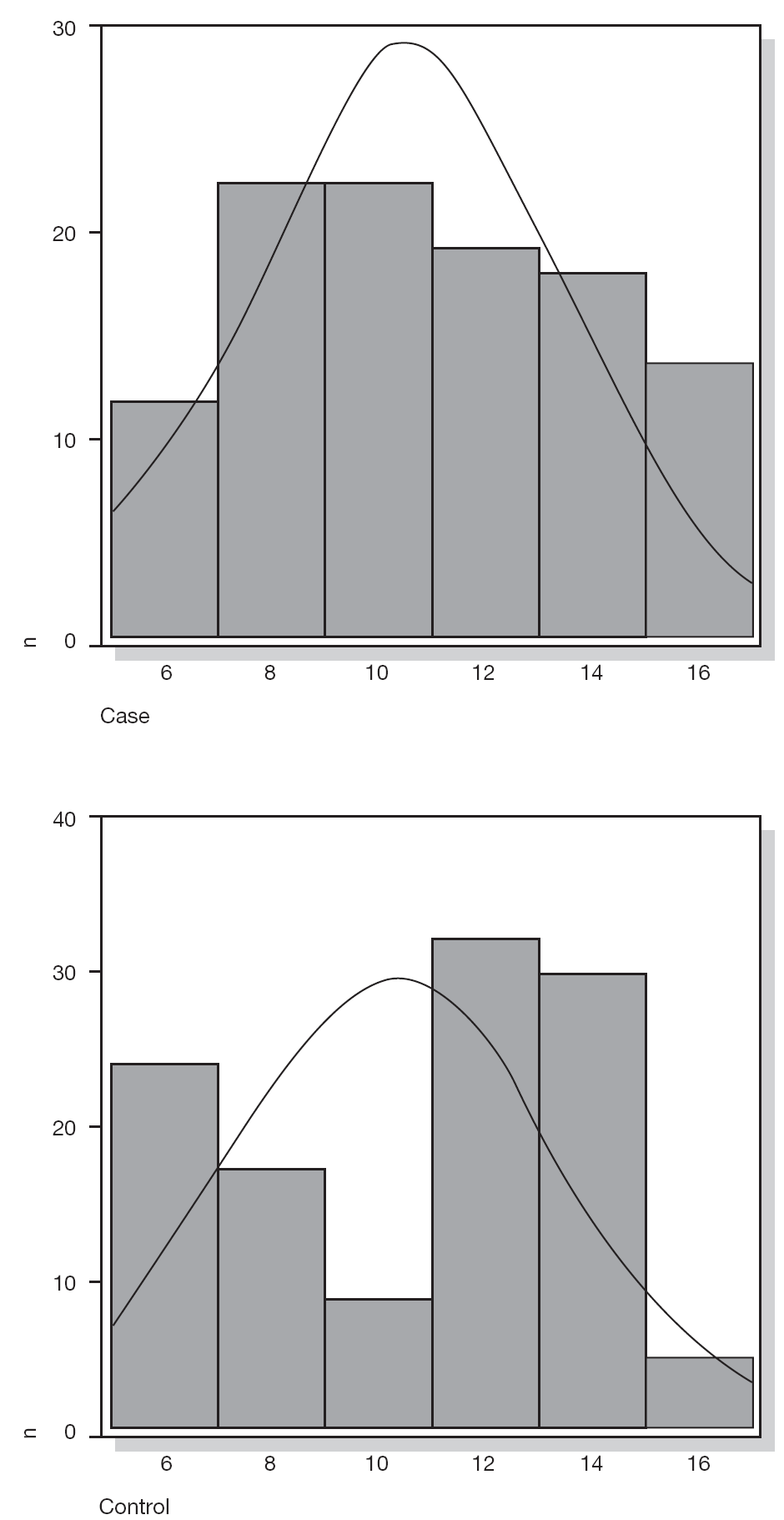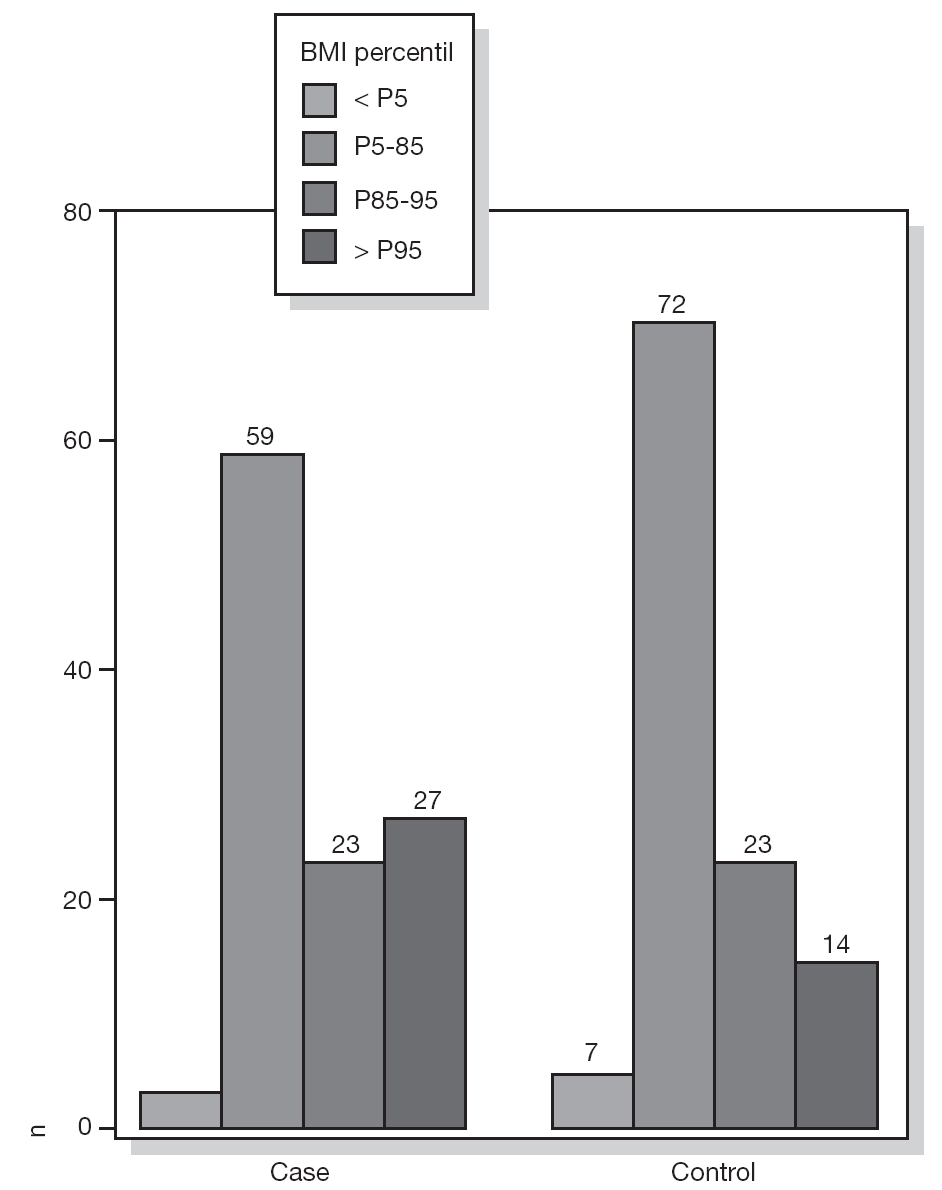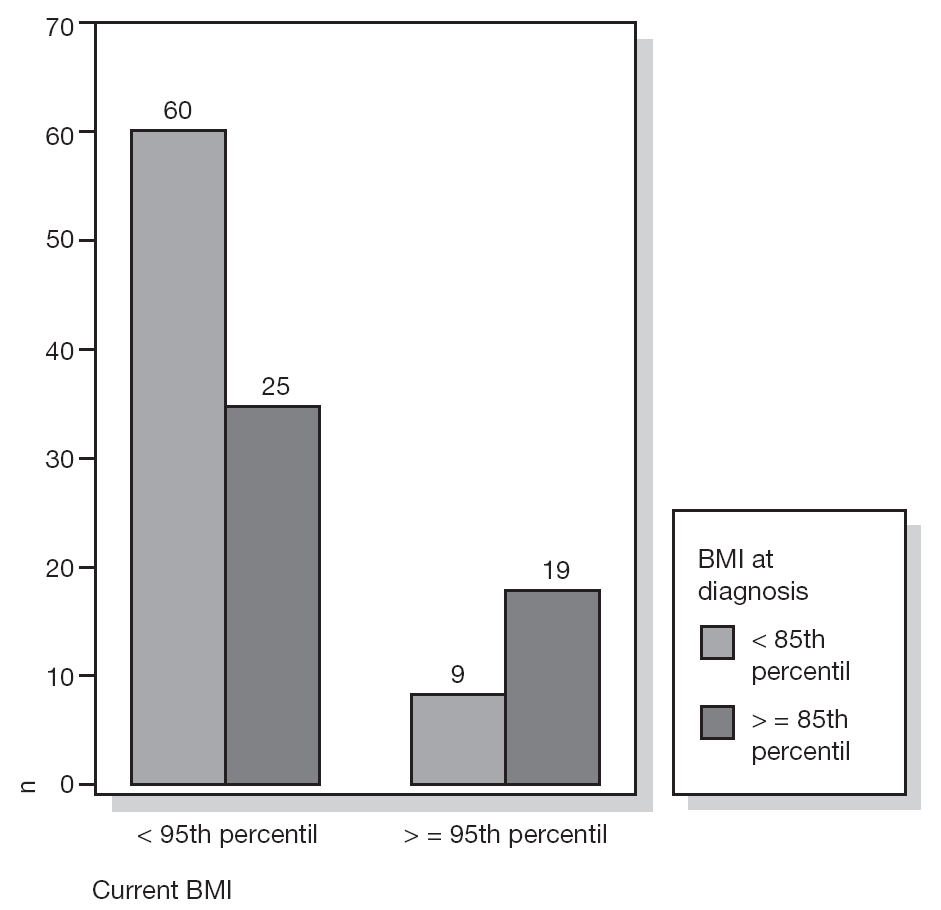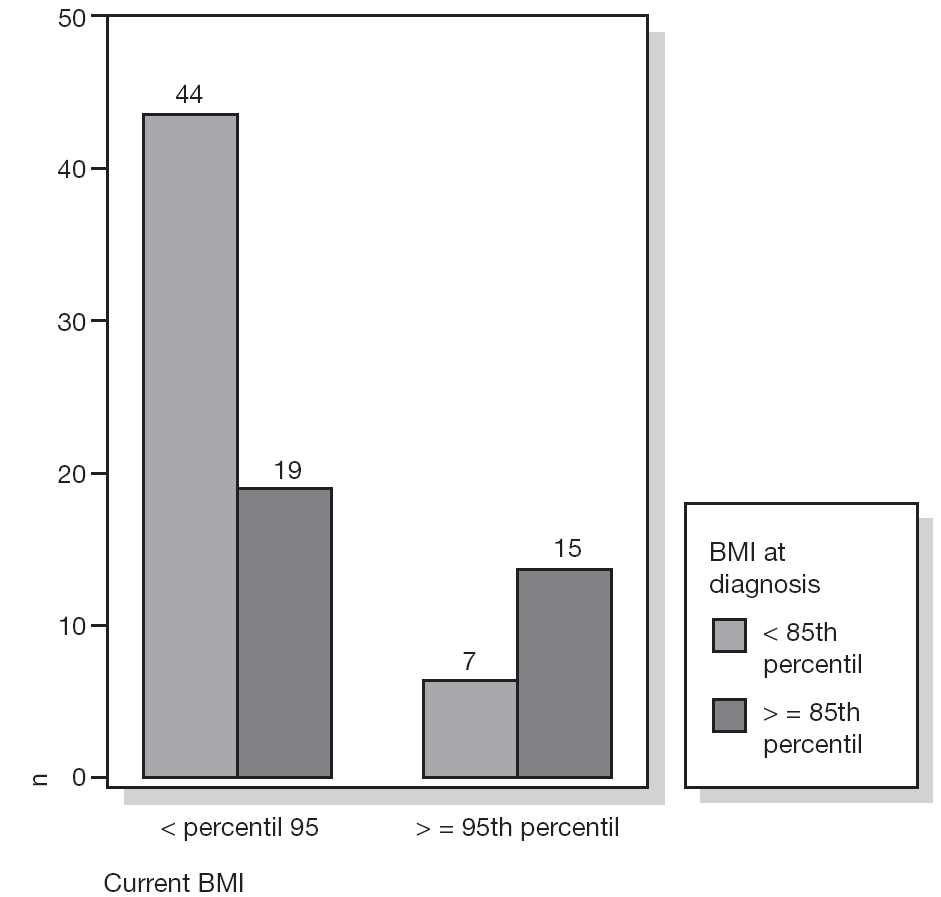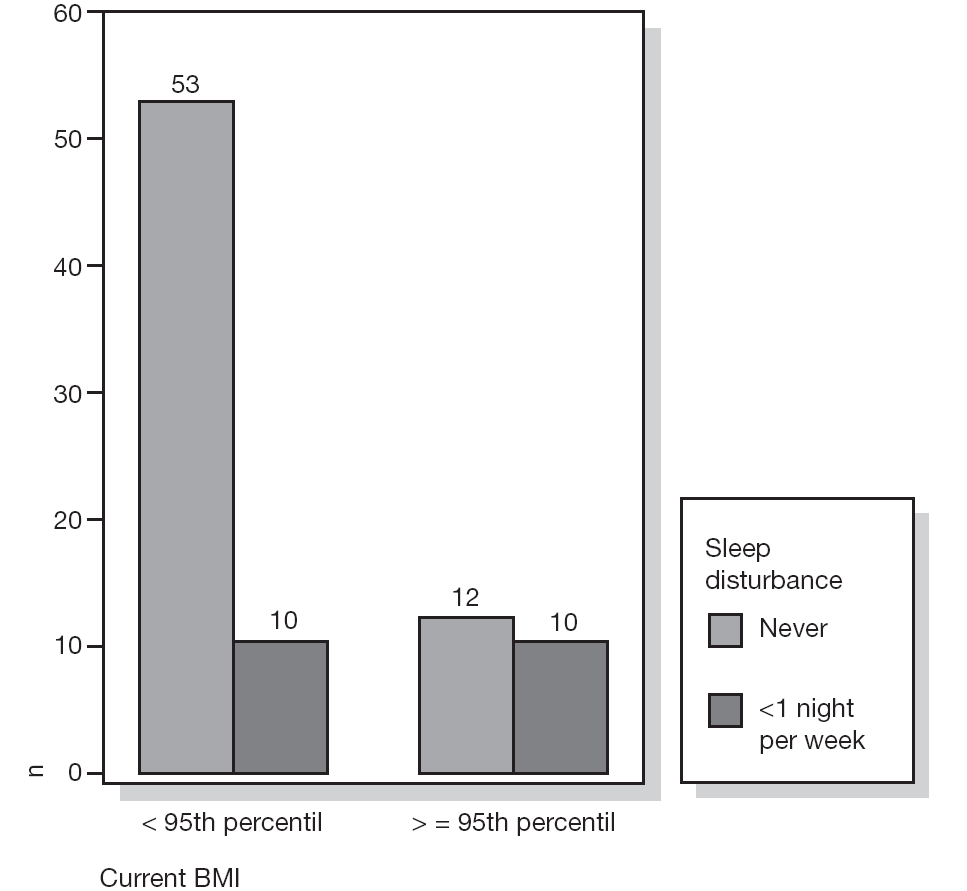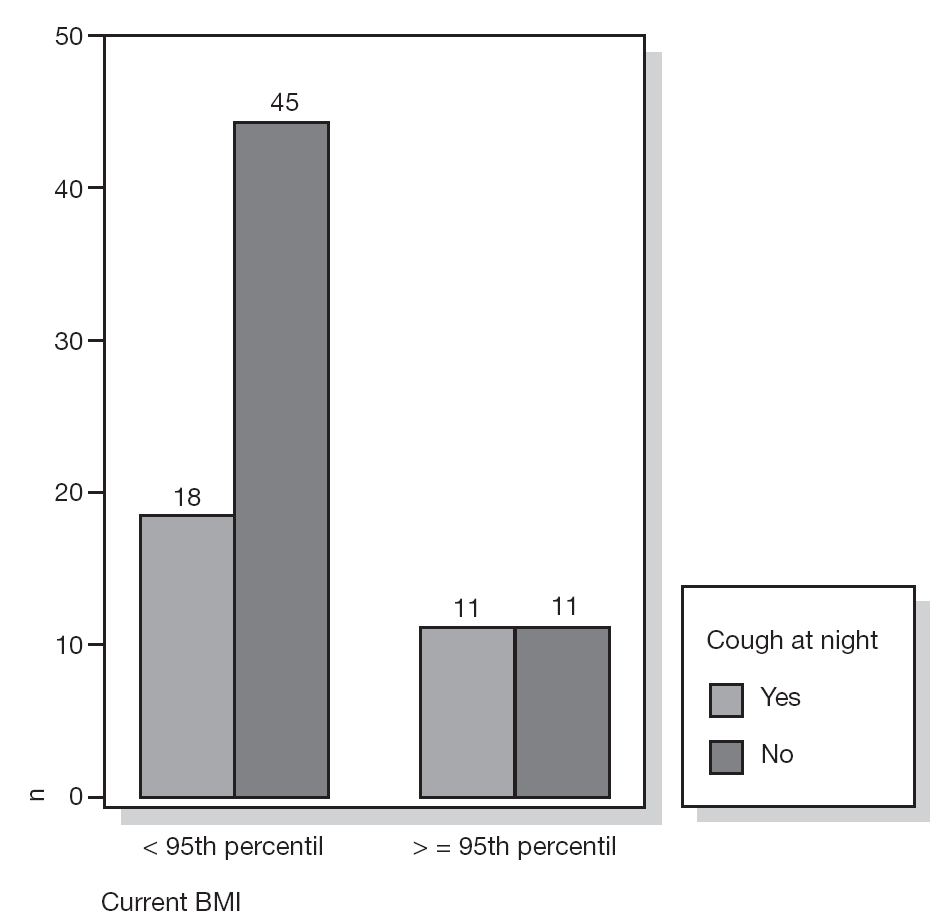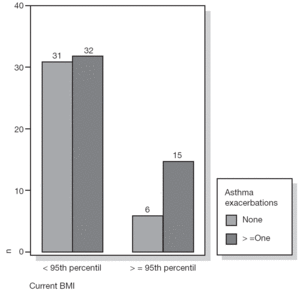BACKGROUND
Over the decades, the prevalence of asthma and obesity has increased1. In effect, they are two increasingly important population health issues in industrialized countries.
The rise in obesity has been attributed to lifestyle changes. However, the increase in asthma prevalence remains largely unexplained1-3. Several recent studies have demonstrated an association between body mass index (BMI) and asthma symptoms, both in adults and in children, suggesting that excess weight and obesity are potential risk factors for asthma1,4-7. Moreover, BMI has been observed to be associated with asthma severity in adults, although conflicting results have been reported in children8,9. The results of the studies in children have not been consistent, and the exact nature of the relationship remains unclear2,10.
The aim of this study was to determine the BMI in children with atopic disease compared with nonatopic children, and to determine whether obesity is associated with more severe disease.
MATERIAL AND METHODS
Study population and data sources
Children aged 5 to 16 years with diagnosed atopic disease that attended the Ambulatory Hospital Center where eligible as cases. The diagnosis of asthma, rhinoconjunctivitis and eczema was ascertained with the ISAAC core questions and other validated questionnaires11. Children aged 5 to 16 years without atopic disease from a school in the same geographic area were used as controls.
After the child removed shoes and heavy clothing, body height and weight were measured as part of the routine health examination in the atopic group and in school, during the gymnastics class, in the control group. Weight and height measurements were made using a balance beam scale and sliding L-shaped arm in accordance with standard clinical techniques. The BMI was calculated as body weight (in kg) divided by the square of height (in m)(kg/m2). The age and sex specific distribution of BMI used as reference was taken from CDC Growth Charts: United States Advance data (From Vital and Health Statistics 2000; 314:1-28). Overweight status was defined as a BMI of > 85th and < 95th percentile, and obesity as a BMI > 95th percentile12.
Questionnaire
The questionnaire addressed information on current age and age at the time of diagnosis, weight at birth, BMI at the time of diagnosis, type of atopic disease (asthma, allergic rhinitis, atopic eczema or alimentary allergy), and current therapy. The questionnaire included the ISAAC core questions on symptoms of asthma, allergic rhinitis and atopic eczema, as reported elsewhere11.
The severity of asthma was assessed by the number, in the last 12 months, of wheezing attacks (none vs 1 to 3, 4 to 12 or more than 12), waking up at night because of wheezing (never, less than one night per week, or one or more nights per week), dry cough at night apart from cough associated with a cold or a chest infection (yes or no), and wheezing during or after exercise.
The severity of rhinitis was assessed by the presence in the past 12 months of sneezing, runny or blocked nose or itchy-watery eyes (yes or no); during which of the past 12 months the nose problem occurred; and by how much it interfered with daily activities (not at all or a little vs a moderate amount or a lot).
The severity of eczema was assessed by the presence of complete regression of the rash in the last 12 months (yes or no) and how often, on average, the child had been kept awake at night by itchy rash (never vs less than one night per week or one or more nights per week).
Statistical analyses
Data were analyzed using the Statistical Package for the Social Sciences (SPSS - PC version 11.5). Pearson's chi-square statistic and chi-square trend were used to determine the significance of differences in prevalence between different BMI groups. For all analyses, p-values of < 0.05 were regarded as significant. The adjusted odds ratio (OR) was calculated by logistic regression.
RESULTS
A total of 228 children where included in the analysis: 112 children with atopy and 116 children without atopy. Asthma, rhinitis and eczema were the three diseases present among the cases. Fifty-seven children had more than one atopic disease.
Asthma was present in 85 children (54 associated to rhinitis and one to eczema), 78 had rhinitis (54 associated to asthma and two to eczema) and 6 had eczema (one case associated to asthma and two to rhinitis). No significant sex differences were found in the case and control groups (fig. 1). Mean age in the atopic group was 10.5 years, with mode 7 years, median 10 years and standard deviation 3.078. In the control group, the mean age was 10.3 years, the mode and median 12, and standard deviation 3.098 (fig. 2).
Figure 1.--Gender distribution of case and control children.
Figure 2.--Age distribution in case and control children.
The prevalence of overweight or obese individuals was significantly higher in the atopic group (44.6 % vs 31.9 %, p < 0.05, fig. 3). A significant positive association between BMI > 85th percentile and atopic disease was found (OR 1.70, 95 % confidence interval 1.70 to 5.03, p = 0.04).
Figure 3.--Current BMI percentile distribution in case and control children.
Most of the obese atopic children (66.7 % vs 29.4 %, p < 0.05) were already overweight or obese at the time of the diagnosis (fig. 4). The same was found only in the obese asthmatic children (68.2 % vs 30.2 %, p < 0.05, fig. 5).
Figure 4.--BMI percentile at the time of atopy diagnosis in the obese and non-obese cases.
Figure 5.--BMI percentile at asthma diagnosis in obese and non-obese asthmatic children.
A significant positive association between BMI > 85th percentile and asthma was also found (47.0 % vs 32.9 %, p < 0.05). No significant positive association was found between rhinitis and eczema and BMI > 85th percentile.
Obese asthmatic children had a significantly higher prevalence of sleep disturbances due to wheezing in the past 12 months (45.5 % vs 15.9 %, p < 0.05, fig. 6). They also reported dry cough at night more often (50 % vs 28.6 %, p = 0.07, fig. 7), and a higher number of wheezing attacks in the past 12 months (72.7 % vs 50.8 %, p = 0.074, fig. 8), than the non-obese asthmatic children.
Figure 6.--Sleep disturbance prevalence in the last 12 months in obese and non-obese asthmatic children.
Figure 7.--Dry cough at night in the last 12 months in obese and non-obese asthmatic children.
Figure 8.--Asthma exacerbations in the last 12 months in obese and non-obese asthmatic children.
There was no association between the presence of rhinitis and overweight status or obesity and symptoms of runny nose, itchy eyes or itchy rash in the past 12 months, symptoms interference in daily activities and symptoms month distribution.
There was no association between the presence of eczema and overweight status or obesity and sleep disturbance due to itchy rash or complete symptoms regression in the past 12 months.
There was no association between overweight status or obese atopic children and birth weight, lifetime physician diagnosis of atopic disease, inhaled or topic steroid use or the use of any medication.
None of the associations were significantly different for boys or girls.
DISCUSSION
In this sample there was a strong association between overweight status / obesity and physician diagnosed asthma in children (with or without other atopic disease). This association was found in both sexes, unlike other studies that report an association between overweight status / obesity and asthma in females only1,13-15. There was no association between overweight status / obesity and other atopic diseases such as rhinitis or eczema.
Children may become overweight or obese as a result of a switch to lesser physical activity after the diagnosis of asthma, or as a consequence of asthma therapy1. This does not appear likely, however, because most obese asthmatic children were already overweight or obese at the time of diagnosis (66.6 %). This suggests that although the time elapsed from the date of diagnosis to appearance of the first symptoms was not evaluated, overweight status / obesity appeared before the atopic disease.
Many other hypotheses have been proposed to explain the association between asthma and obesity. One possibility is that obesity and asthma share common risk factors3,16. An increase in sedentary lifestyle may be responsible for the increase in obesity, whereas the coinciding increase in time spent indoors may contribute to the rise in asthma prevalence via increased exposure to household allergens. Overweight status and obesity might be associated with reduced airways caliber as a result of chest wall restriction caused by fat deposition1,16,18. Dietary factors could also confound the association between asthma and obesity. An evaluation of physical activity and diet could help to confirm or refute the hypotheses of sedentary lifestyle as a common denominator for atopy and excess body weight / obesity.
In this study, the association between obesity and asthma was related to the severity of asthma. Obese asthmatic children showed a significantly higher prevalence of sleep disturbances due to wheezing in the past 12 months, and they also reported dry cough at night more often, and a higher number of wheezing attacks in the past 12 months than the non-obese asthmatic children. The association between a higher BMI and symptoms of wheezing and cough in children has been observed in previous studies10,15,19. However, wheezing and cough are nonspecific symptoms that can be attributed to a number of different causes, including asthma. Increased BMI is associated with an increase in the occurrence of both gastroesophageal reflux and sleep apnea, and both of these conditions may be a cause of symptoms of wheezing1,20. Obesity is associated to exertion dyspnea - a symptom that can mimic asthma. An evaluation of airway obstruction and hyper-responsiveness should be performed to confirm that the excess of symptoms among obese children is not due to causes other than asthma.
Excess weight could inadvertently lead to the prescription of a less intensive treatment regimen, or to poorer compliance in order to increase a potential adverse effect of treatments. New hypotheses are urgently needed to explain the rise in asthma in developed countries, so that preventive strategies can be devised.
Other potential confounding factors in the association between overweight status / obesity and atopic disease should be excluded, such as a family history of obesity or atopic disease, or smoking at home.
We found no sex differences in the relationship between BMI and asthma or atopy.
Correspondence:
Marta João Rodrigues Silva
Cirugia General Hospital São João
Rua das Mimosas, 39
Milheiros. 4475-079 Maia. Portugal
Phone: 00351966123421; Fax: 003512229600017
E-Mail: martajoaosilva@iol.pt





